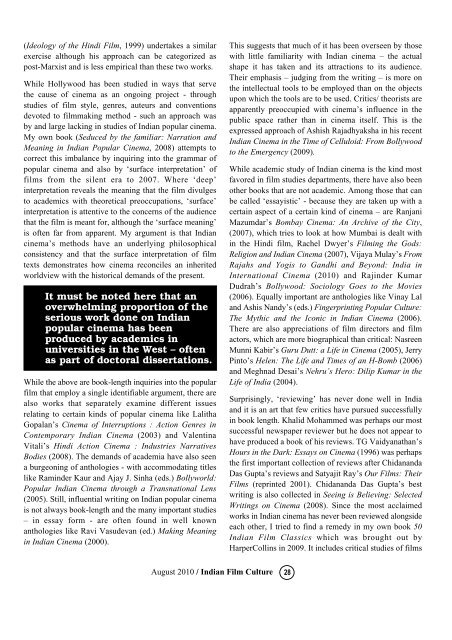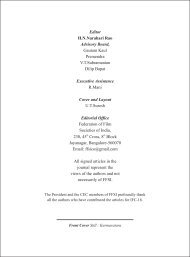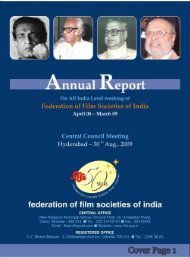Indian Film Culture.P65 - federation of film societies of india
Indian Film Culture.P65 - federation of film societies of india
Indian Film Culture.P65 - federation of film societies of india
You also want an ePaper? Increase the reach of your titles
YUMPU automatically turns print PDFs into web optimized ePapers that Google loves.
(Ideology <strong>of</strong> the Hindi <strong>Film</strong>, 1999) undertakes a similar<br />
exercise although his approach can be categorized as<br />
post-Marxist and is less empirical than these two works.<br />
While Hollywood has been studied in ways that serve<br />
the cause <strong>of</strong> cinema as an ongoing project - through<br />
studies <strong>of</strong> <strong>film</strong> style, genres, auteurs and conventions<br />
devoted to <strong>film</strong>making method - such an approach was<br />
by and large lacking in studies <strong>of</strong> <strong>Indian</strong> popular cinema.<br />
My own book (Seduced by the familiar: Narration and<br />
Meaning in <strong>Indian</strong> Popular Cinema, 2008) attempts to<br />
correct this imbalance by inquiring into the grammar <strong>of</strong><br />
popular cinema and also by ‘surface interpretation’ <strong>of</strong><br />
<strong>film</strong>s from the silent era to 2007. Where ‘deep’<br />
interpretation reveals the meaning that the <strong>film</strong> divulges<br />
to academics with theoretical preoccupations, ‘surface’<br />
interpretation is attentive to the concerns <strong>of</strong> the audience<br />
that the <strong>film</strong> is meant for, although the ‘surface meaning’<br />
is <strong>of</strong>ten far from apparent. My argument is that <strong>Indian</strong><br />
cinema’s methods have an underlying philosophical<br />
consistency and that the surface interpretation <strong>of</strong> <strong>film</strong><br />
texts demonstrates how cinema reconciles an inherited<br />
worldview with the historical demands <strong>of</strong> the present.<br />
It must be noted here that an<br />
overwhelming proportion <strong>of</strong> the<br />
serious work done on <strong>Indian</strong><br />
popular cinema has been<br />
produced by academics in<br />
universities in the West – <strong>of</strong>ten<br />
as part <strong>of</strong> doctoral dissertations.<br />
While the above are book-length inquiries into the popular<br />
<strong>film</strong> that employ a single identifiable argument, there are<br />
also works that separately examine different issues<br />
relating to certain kinds <strong>of</strong> popular cinema like Lalitha<br />
Gopalan’s Cinema <strong>of</strong> Interruptions : Action Genres in<br />
Contemporary <strong>Indian</strong> Cinema (2003) and Valentina<br />
Vitali’s Hindi Action Cinema : Industries Narratives<br />
Bodies (2008). The demands <strong>of</strong> academia have also seen<br />
a burgeoning <strong>of</strong> anthologies - with accommodating titles<br />
like Raminder Kaur and Ajay J. Sinha (eds.) Bollyworld:<br />
Popular <strong>Indian</strong> Cinema through a Transnational Lens<br />
(2005). Still, influential writing on <strong>Indian</strong> popular cinema<br />
is not always book-length and the many important studies<br />
– in essay form - are <strong>of</strong>ten found in well known<br />
anthologies like Ravi Vasudevan (ed.) Making Meaning<br />
in <strong>Indian</strong> Cinema (2000).<br />
August 2010 / <strong>Indian</strong> <strong>Film</strong> <strong>Culture</strong> 28<br />
This suggests that much <strong>of</strong> it has been overseen by those<br />
with little familiarity with <strong>Indian</strong> cinema – the actual<br />
shape it has taken and its attractions to its audience.<br />
Their emphasis – judging from the writing – is more on<br />
the intellectual tools to be employed than on the objects<br />
upon which the tools are to be used. Critics/ theorists are<br />
apparently preoccupied with cinema’s influence in the<br />
public space rather than in cinema itself. This is the<br />
expressed approach <strong>of</strong> Ashish Rajadhyaksha in his recent<br />
<strong>Indian</strong> Cinema in the Time <strong>of</strong> Celluloid: From Bollywood<br />
to the Emergency (2009).<br />
While academic study <strong>of</strong> <strong>Indian</strong> cinema is the kind most<br />
favored in <strong>film</strong> studies departments, there have also been<br />
other books that are not academic. Among those that can<br />
be called ‘essayistic’ - because they are taken up with a<br />
certain aspect <strong>of</strong> a certain kind <strong>of</strong> cinema – are Ranjani<br />
Mazumdar’s Bombay Cinema: An Archive <strong>of</strong> the City,<br />
(2007), which tries to look at how Mumbai is dealt with<br />
in the Hindi <strong>film</strong>, Rachel Dwyer’s <strong>Film</strong>ing the Gods:<br />
Religion and <strong>Indian</strong> Cinema (2007), Vijaya Mulay’s From<br />
Rajahs and Yogis to Gandhi and Beyond: India in<br />
International Cinema (2010) and Rajinder Kumar<br />
Dudrah’s Bollywood: Sociology Goes to the Movies<br />
(2006). Equally important are anthologies like Vinay Lal<br />
and Ashis Nandy’s (eds.) Fingerprinting Popular <strong>Culture</strong>:<br />
The Mythic and the Iconic in <strong>Indian</strong> Cinema (2006).<br />
There are also appreciations <strong>of</strong> <strong>film</strong> directors and <strong>film</strong><br />
actors, which are more biographical than critical: Nasreen<br />
Munni Kabir’s Guru Dutt: a Life in Cinema (2005), Jerry<br />
Pinto’s Helen: The Life and Times <strong>of</strong> an H-Bomb (2006)<br />
and Meghnad Desai’s Nehru’s Hero: Dilip Kumar in the<br />
Life <strong>of</strong> India (2004).<br />
Surprisingly, ‘reviewing’ has never done well in India<br />
and it is an art that few critics have pursued successfully<br />
in book length. Khalid Mohammed was perhaps our most<br />
successful newspaper reviewer but he does not appear to<br />
have produced a book <strong>of</strong> his reviews. TG Vaidyanathan’s<br />
Hours in the Dark: Essays on Cinema (1996) was perhaps<br />
the first important collection <strong>of</strong> reviews after Chidananda<br />
Das Gupta’s reviews and Satyajit Ray’s Our <strong>Film</strong>s: Their<br />
<strong>Film</strong>s (reprinted 2001). Chidananda Das Gupta’s best<br />
writing is also collected in Seeing is Believing: Selected<br />
Writings on Cinema (2008). Since the most acclaimed<br />
works in <strong>Indian</strong> cinema has never been reviewed alongside<br />
each other, I tried to find a remedy in my own book 50<br />
<strong>Indian</strong> <strong>Film</strong> Classics which was brought out by<br />
HarperCollins in 2009. It includes critical studies <strong>of</strong> <strong>film</strong>s





